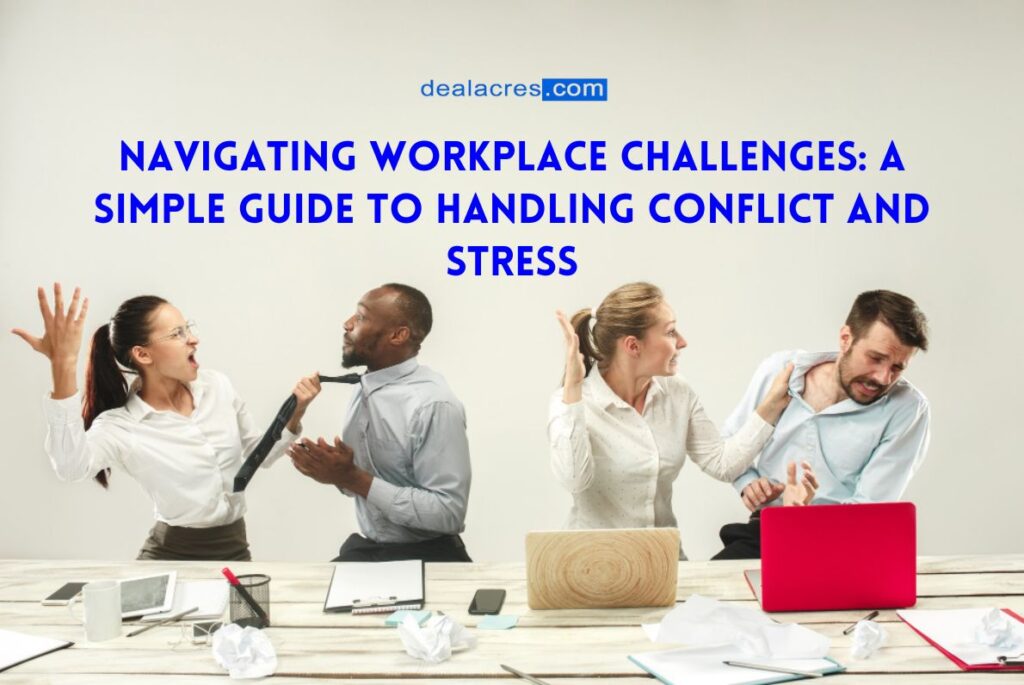Introduction:
Workplaces can sometimes be tricky to navigate, and it’s normal to encounter challenges like conflicts and stress. But don’t worry – we’ve got your back! In this guide, we’ll explore easy and simple ways to handle these situations. By the end, you’ll have some handy tools to make your work life smoother, even when things get a little tough.
Section 1: Understanding Workplace Conflict
Conflict at work can make things uncomfortable, but it’s essential to understand that it happens everywhere. This section breaks down what workplace conflict is, the common reasons behind it, and how it can affect you and your colleagues. We’ll also discuss the importance of addressing conflicts early on to prevent them from escalating.

Section 2: Effective Communication
Communication is a superpower when it comes to resolving conflicts. Here, we’ll explore the basics of effective communication – how to express yourself clearly and listen to others. You’ll learn about using “I” statements, active listening, and the power of empathy. These skills can make a huge difference in turning conflicts into opportunities for understanding.
Section 3: Conflict Resolution Strategies
Now that we’ve covered communication, let’s delve into practical conflict resolution strategies. We’ll explore techniques like finding common ground, compromising, and seeking mediation. These simple approaches can help you and your colleagues find solutions that everyone can agree on, making the workplace a more harmonious space.
Section 4: Coping with Workplace Stress
Stress is another common challenge in the workplace. In this section, we’ll discuss what stress is, how it affects your well-being, and common stressors at work. You’ll also discover simple stress management techniques, such as mindfulness, time management, and setting realistic goals. These tools can help you navigate stressful situations with ease.
Section 5: Building a Supportive Workplace Culture
Creating a supportive workplace culture is crucial for handling conflicts and stress. We’ll explore the role of teamwork, mutual respect, and positive communication in fostering a healthy work environment. By understanding the importance of collaboration, you can contribute to building a workplace where everyone feels valued and supported.

Section 6: Seeking Help When Needed
Sometimes, conflicts and stress can feel overwhelming. This section emphasizes the importance of seeking help when necessary. Whether it’s talking to a supervisor, HR, or a trusted colleague, knowing when to ask for support is a sign of strength. We’ll discuss how reaching out can lead to effective solutions and prevent issues from escalating.
Section 7: Work-Life Balance
Maintaining a healthy work-life balance is essential for overall well-being. We’ll explore tips for setting boundaries, managing time efficiently, and taking breaks to recharge. Balancing work and personal life can significantly reduce stress and contribute to a more fulfilling professional and personal life.

Section 8: Reflecting on Personal Growth
Finally, we’ll wrap up by discussing the importance of personal growth in navigating workplace challenges. Reflection and continuous improvement are powerful tools for building resilience and adaptability. By embracing a growth mindset, you can turn challenges into opportunities for learning and development.
Conclusion:
In the grand scheme of our work lives, dealing with conflicts and stress might seem like climbing a mountain. However, the good news is that it doesn’t have to be an insurmountable challenge. Armed with some straightforward strategies and a positive mindset, you can turn these hurdles into stepping stones for personal and professional growth.
Effective communication acts as a powerful ally in the realm of workplace challenges. It’s the cornerstone for resolving conflicts and fostering understanding among colleagues. By expressing yourself clearly and listening actively, you create a space for open dialogue. Remember the magic of “I” statements – framing your thoughts in a way that emphasizes your feelings rather than pointing fingers can make a significant difference. Add a sprinkle of empathy to the mix, and you’ll find conflicts evolving into opportunities for connection and collaboration.
Now, let’s talk about conflict resolution strategies. Picture conflicts as puzzles waiting to be solved. Seeking common ground, compromising, and, if necessary, bringing in a neutral mediator are simple yet effective ways to piece together a solution. The goal is not just to fix the immediate issue but to build bridges for smoother communication and collaboration in the future. It’s about transforming conflicts into catalysts for positive change.
Stress, another common companion in the workplace, often sneaks in uninvited. But fear not – managing stress is like taming a wild beast with a few simple tricks. Mindfulness, time management, and setting realistic goals are potent tools at your disposal. Incorporating these into your daily routine can create a shield against stress, allowing you to face challenges with resilience and composure.
Now, let’s shift our focus to the broader canvas of workplace culture. Imagine a workplace where teamwork is the norm, respect is the language, and positive communication is the air everyone breathes. Building such a supportive culture is not an individual effort but a collective one. By contributing to a positive work environment; you become part of a team that helps each other grow and thrive.
Remember, seeking help is not a sign of weakness but a demonstration of wisdom. If conflicts or stress become too heavy to carry alone, don’t hesitate to reach out. Whether it’s talking to a supervisor, HR, or a trusted colleague, seeking support is a courageous step toward resolution. Together, you can find solutions that might have been elusive on your own.
Maintaining a healthy work-life balance is akin to finding the right rhythm in a dance. Set boundaries, manage your time wisely, and don’t forget to take breaks. A well-balanced life not only reduces stress but also enhances your overall well-being. It’s a delicate dance, but with practice, you’ll find the harmony that suits you best.
As we conclude this guide, reflect on the concept of personal growth. Embrace challenges as opportunities to learn and develop. A growth mindset transforms setbacks into stepping stones, and each experience – be it a conflict or a stressful situation – becomes a chapter in your journey of continuous improvement.
In the grand tapestry of your professional life, handling workplace conflicts and stress is not just about survival; it’s about thriving. With effective tools, a positive mindset, and a commitment to growth, you’re not just navigating challenges – you’re turning them into the building blocks of a fulfilling and successful career. So, go forth, armed with these simple yet powerful strategies, and make your workplace a space where challenges are conquered and success is not just a destination but a way of life.




